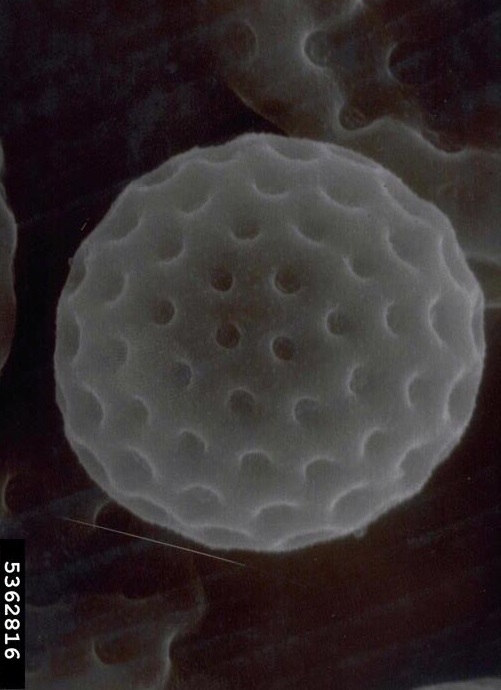 Pollen Allergies - February 5, 2014 Jeff Schalau, Agent, Agriculture & Natural Resources University of Arizona Cooperative Extension, Yavapai County I’ve received a few inquiries as to why pollen allergies seem to have come earlier this year. I’m no expert in pollen counting or allergies, but it could be linked to recent periods of above average temperatures coupled with an extended period of no precipitation. Pollen is to be expected, but its presence is often tempered by winter precipitation which usually washes the pollen from the air. It could be that the extended dry period has allowed pollen to remain airborne longer. Regardless, many people suffer from pollen allergies and I would like to describe some of the offending plants and provide some resources where consumers can find reliable information. Pollen is shed by many plants that flower seasonally (usually spring or fall). The plants with the greatest impact on allergies are wind-pollenated. These plants release pollen which is carried by wind (up to 20 miles) to the female flowers of their various species. This reproductive strategy leads to an environment virtually saturated with pollen for brief periods of the year. Pollens themselves are the tiny, male reproductive structures of flowering plants. Attractive, brightly colored flowers that are pollinated only by insects rarely cause allergies. Trees that can cause pollen allergies include: juniper, cypress, mesquite, mulberry, cottonwood, pecan, sycamore, desert broom, elm, walnut, oak, olive, and palm. Pines also produce pollen, but it is generally not considered allergenic. Offending grasses and herbaceous plants include: bermudagrass, johnsongrass, ryegrass, alfalfa, pigweed, cocklebur, lambs quarter, ragweed, and Russian thistle (tumbleweed). This is not an all-inclusive list, but it probably contains most of our worst allergenic pollen producers. The “allergen problem” can be been made worse by the introduction of exotic species to our landscapes and has cause various communities to limit or ban the planting of olive and mulberry trees. Most pollen will become an allergen if a susceptible person is exposed to a sufficient quantity of it. Pollen allergy symptoms often include nasal stuffiness, runny nose, sneezing, itching in the nose and throat, itchy, watery red eyes, fatigue, and headache. According to the University of Arizona Health Sciences Center, allergies affect at least 35% of the population and often need treatment to improve quality of life and reduce risk of complications. It is sometimes useful for allergy sufferers to know which pollen species are present at any given time. This is done by conducting a pollen count. Pollen counts measure the amount of airborne allergens present in the air at the time of sample collection. Counts are reported as grains per cubic meter of air. Certified aeroallergen counters at many universities, medical centers and clinics often provide these counts on a volunteer basis. The American Academy of Allergy, Asthma and Immunology (AAAAI) has a network of pollen counters across the United States. Each counter works under the direction of an AAAAI member and must first pass an intensive certification course. Counters use air sampling equipment to capture air-borne pollens. Data from AAAAI can be accessed on the Internet at: www.aaaai.org. Unfortunately, we currently have no observation stations in Arizona. However, the University of Arizona Health Sciences Center has some information on pollen allergies and plants that cause them. Another pollen forecasting resource is available, and while I often avoid recommending “dot com” resources because of commercial ties and the potential for lack of scientific objectivity, I think that www.pollen.com could be of value to readers suffering from pollen allergies. They have a network of collaborators that monitor pollen using standardized methods. They have maps and forecasts by zip code as well as customized products delivered via e-mail and smartphone. I write the Backyard Gardener one week before publication, but as I was writing, the forecast was for medium amounts of allergenic pollen decreasing due to a slight chance of precipitation. The predominant pollen arose from juniper. Let’s hope that we do get some more precipitation this winter! Follow the Backyard Gardener on Twitter – use the link on the BYG website. If you have other gardening questions, call the Master Gardener help line in the Camp Verde office at 928-554-8999 Ext. 3 or e-mail us at verdevalleymg@gmail.com and be sure to include your name, address and phone number. Find past Backyard Gardener columns or provide feedback at the Backyard Gardener web site: http://cals.arizona.edu/yavapai/anr/hort/byg/. Additional Resources Allergy and Asthma in the Southwestern United States, University of Arizona Allied Health Sciences http://allergy.peds.arizona.edu/southwest/ Pollen.com http://www.pollen.com The American Academy of Allergy, Asthma and Immunology http://www.aaaai.org/ |